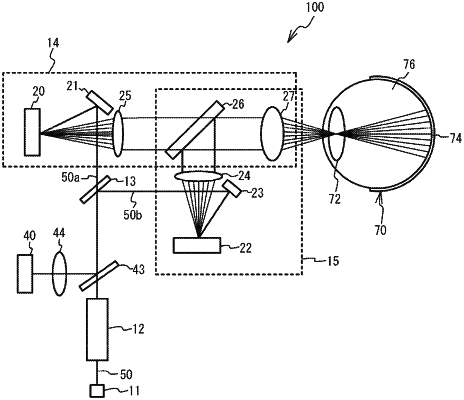| CPC A61B 3/1225 (2013.01) [A61B 3/0025 (2013.01); A61B 3/0058 (2013.01); A61B 3/0091 (2013.01); A61B 3/024 (2013.01); A61B 3/1025 (2013.01)] | 13 Claims |

|
1. A visual sense examination device, comprising:
a beam source that emits a visible beam and an invisible beam;
a visible beam optical system that includes a first scanner two-dimensionally scanning the visible beam, and that emits the visible beam to a retina of a subject;
an invisible beam optical system that includes a second scanner two-dimensionally scanning the invisible beam, and that emits the invisible beam to the retina of the subject;
a detector that detects the invisible beam reflected by the retina of the subject;
a controller that performs a first control, the first control including:
controlling the emission of the visible beam from the beam source, and causing the first scanner to scan the visible beam for an image for projecting the image and to emit the visible beam for the image to the retina of the subject;
controlling the emission of the invisible beam from the beam source, and causing the second scanner to scan the invisible beam for detecting a state of a fundus of the subject and to emit the invisible beam to the retina of the subject; and
acquiring a first fundus image of an eye of the subject from an output signal of the detector based on the invisible beam for detecting the state of the fundus of the subject;
synthesizer that synthesizes the visible beam scanned by the first scanner and the invisible beam scanned by the second scanner; and
wherein a scanning angle of the visible beam by the first scanner and a scanning angle of the invisible beam by the second scanner are substantially the same,
an angle of emission from the synthesizer of the visible beam scanned two-dimensionally by the first scanner and an angle of emission from the synthesizer of the invisible light scanned two-dimensionally by the second scanner are substantially the same, and
a projectable range of the visible beam scanned two-dimensionally by the first scanner and a projectable range of the invisible light scanned two-dimensionally by the second scanner are substantially the same on the retina of the subject.
|